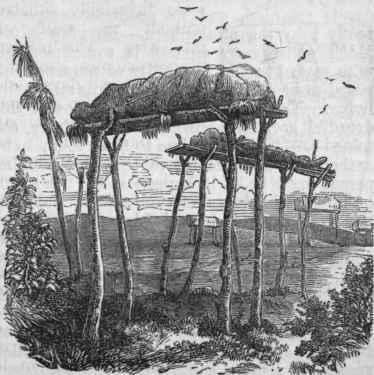


Views On Death[edit]
Death in Aboriginal religion in some aspects may seem like it has some Western traditions in regard to having a ceremony and mourning the loss of the person that is deceased. But that is really the only thing that this religion has in common with Western religion as far as death is concerned. "For Aboriginal people when a person dies some form of the persons spirit and also their bones go back to the country they were born in".[5] "Aborigine people believe that they share their being with their country and all that is within it". "So when a person dies their country suffers, trees die and become scarred because it is believed that came into being because of the deceased person".[5]
When an Aborigine person dies the families have death ceremonies called the "Sorry Business". "During this time the entire community and family mourns the loss of the person for days". "They are expected to cry together and share grief as a community". If someone was out of town and arrives after they have had a ceremony for the deceased, the entire community stops what they are doing and goes and tells them and mourns with them. "The family of the deceased all stay in one room and mourn for their loved one".[6]
"Naming a person after they have died is not allowed in the Aborigine religion". "To say someone's name after they die would be to disturb their spirit ".[6] Photos of the deceased are not allowed for fear of disturbing the spirit also. Many Aborigine families will not have any photographs of their loved ones after they die. "A smoking ceremony is also conducted when someone dies". "The community uses smoke on the belongings and also the residence of the decease to help release the spirit". "Identifying the cause of death is determined by elders who hold the cultural authority to do so, and the causes in question are usually of a spiritual nature". "The ceremonies are likened to an autopsy of Western practice" .
Ceremonies and mourning periods last days, weeks and even sometimes months depending upon the social status of the deceased person. It is culturally inappropriate for a non-Aboriginal person to contact and inform the next of kin of a person’s passing.[6] When someone passes away, the family of the deceased move out of their house and another family then moves in. Some families will move to "sorry camps" which are usually further away.[6] Mourning includes the recital of symbolic chants, the singing of songs, dance, body paint, and cuts on the bodies of the mourners. The body is placed on a raised platform for several months, covered in native plants. Sometimes a cave or a tree is used instead. "When nothing but bones are left, family and friends will scatter them in a variety of ways. They sometimes wrap the bones in a hand-knitted fabric and place them in a cave for eventual disintegration or place them in a naturally hollowed out log".[6]
The Aboriginals believe in a place called the "Land of the Dead". This place was also commonly known as the "sky-world", which is really just the sky. As long as certain rituals were carried out during their life and at the time of their death, the deceased is allowed to enter The Land of the Dead in the "Sky World". The spirit of the dead is also a part of different lands and sites and then those areas become sacred sites. This explains why the Aboriginals are very protective of sites they call sacred. The Aboriginals believe that life is a never-ending cycle. You are born, you die, you are born again as an animal, human or other life form .
The rituals that are performed enable the aborigine to return to the womb of all time which is another word for "Dream Time". It allows the spirit to be connected once more to all nature, to all their ancestors, and to their own personal meaning and place within the scheme of things. "The Dreamtime is a return to the real existence for the aborigine". "Life in time is simply a passing phase – a gap in eternity". It has a beginning and it has an end. "The experience of Dreamtime, whether through ritual or from dreams, flowed through into the life in time in practical ways". "The individual who enters the Dreamtime feels no separation between themselves and their ancestors". "The strengths and resources of the timeless enter into what is needed in the life of the present". "The future is less uncertain because the individual feels their life as a continuum linking past and future in unbroken connection". Through Dreamtime the limitations of time and space are overcome.[7] For the Aborigine people dead relatives are very much a part of continuing life. It is believed that in dreams dead relatives communicate their presence." At times they may bring healing if the dreamer is in pain". "Death is seen as part of a cycle of life in which one emerges from Dreamtime through birth, and eventually returns to the timeless, only to emerge again. It is also a common belief that a person leaves their body during sleep, and temporarily enters the Dreamtime".[7]